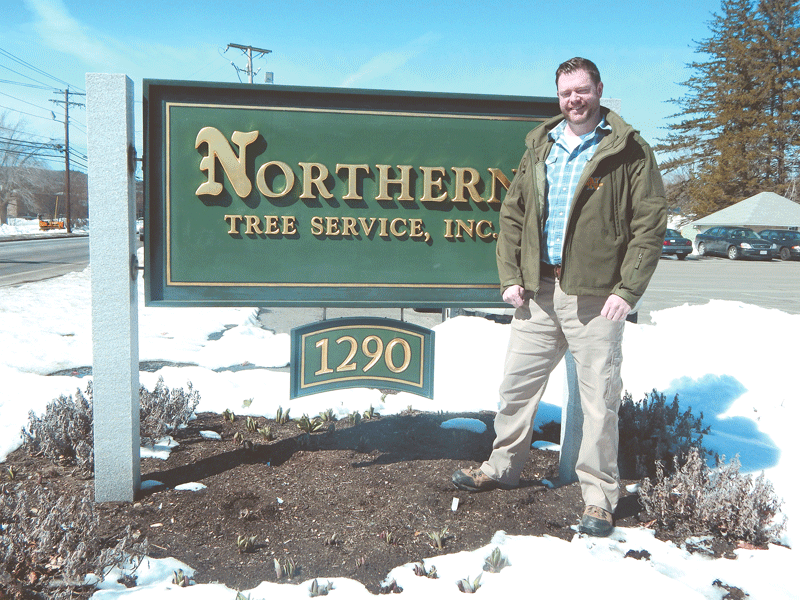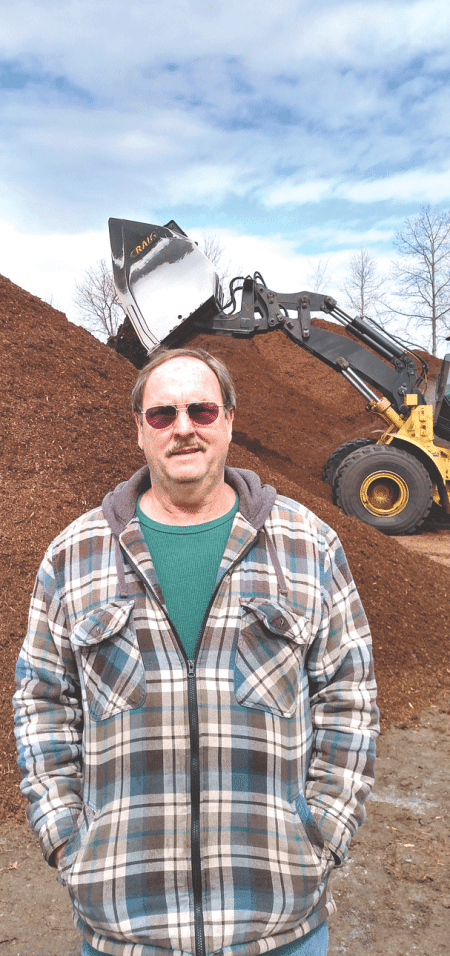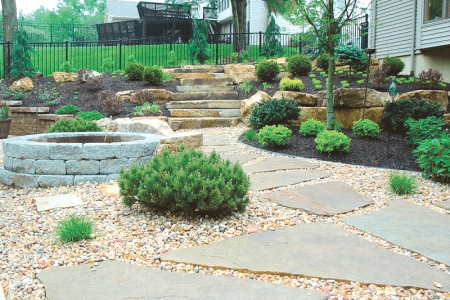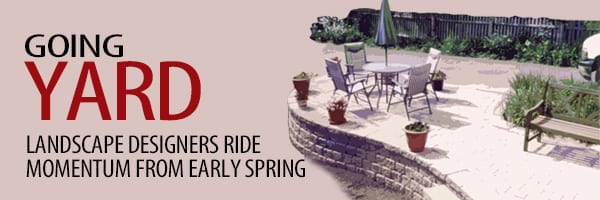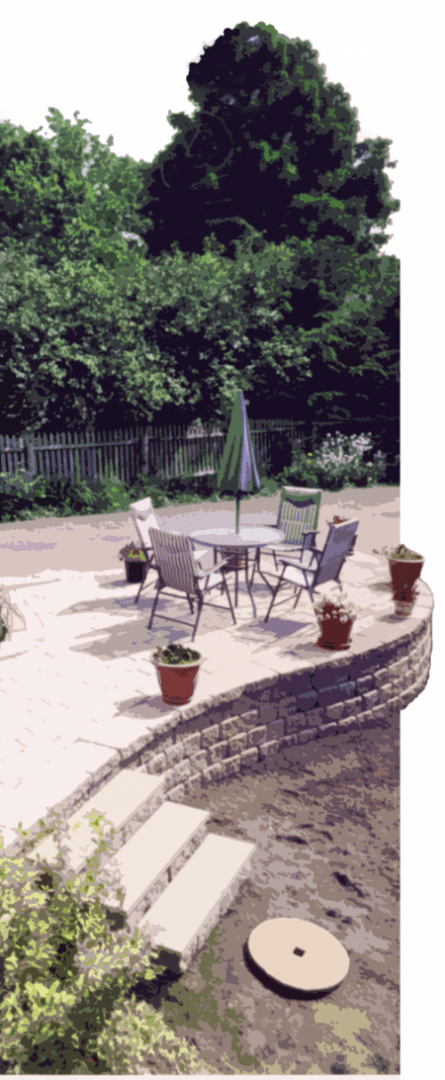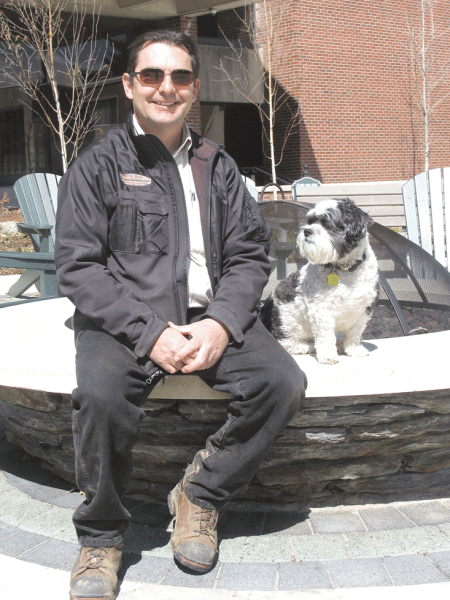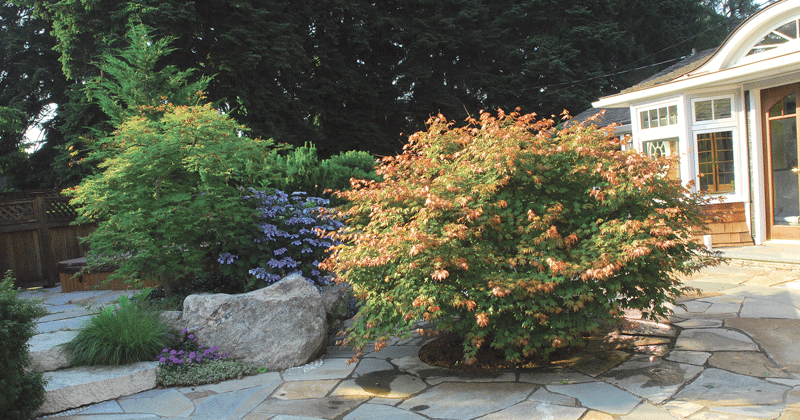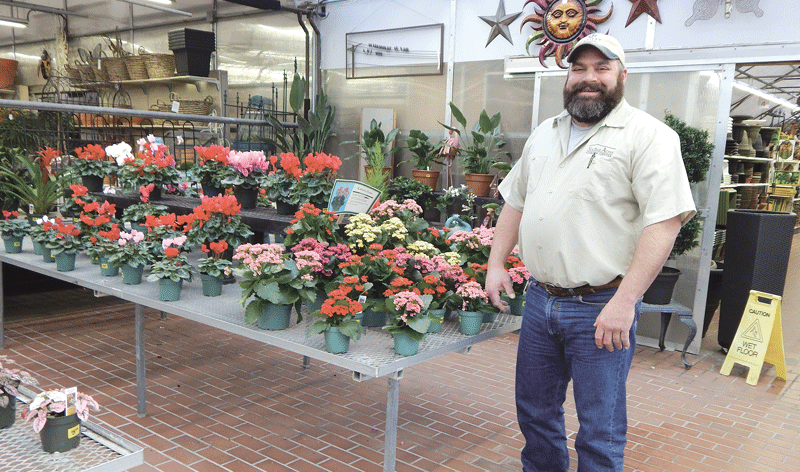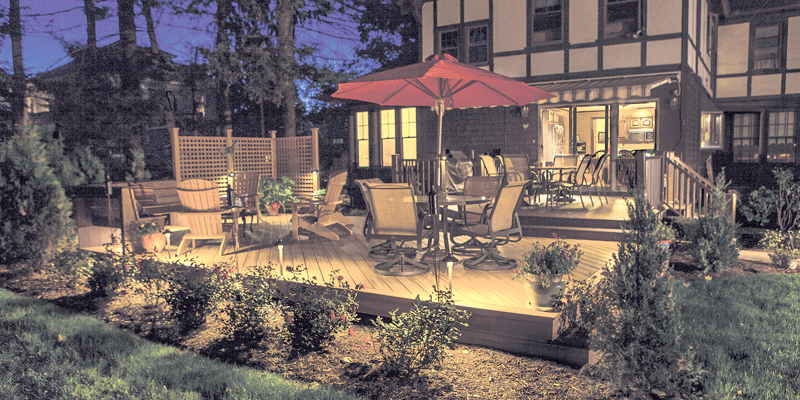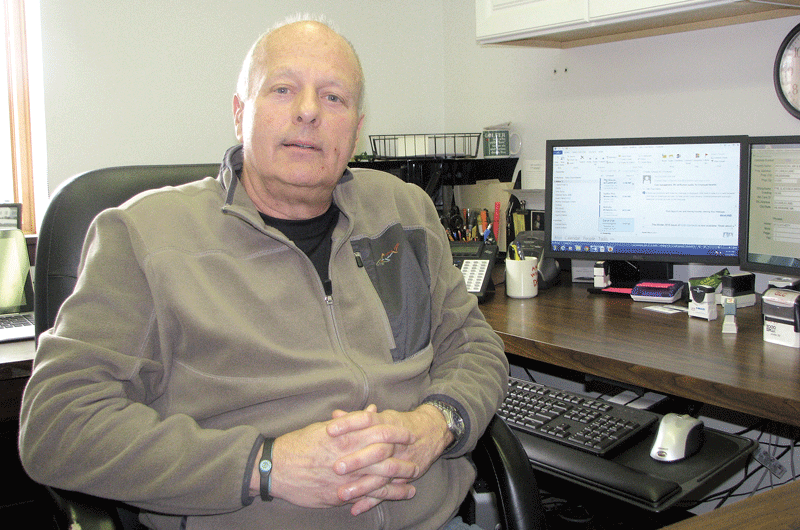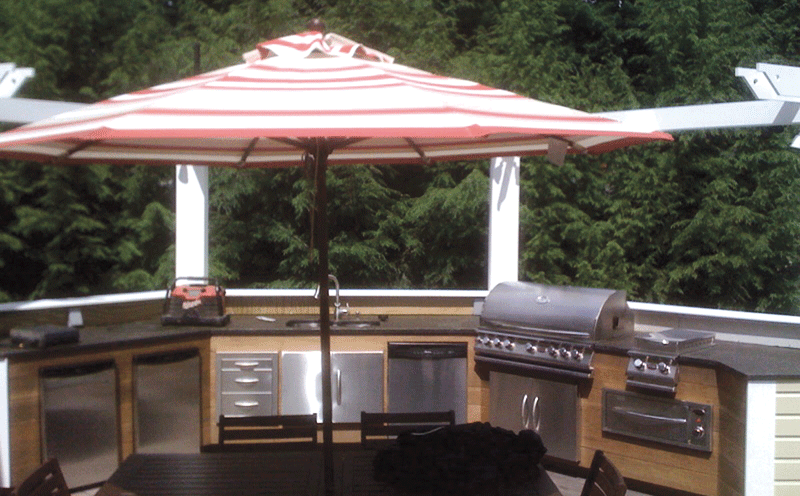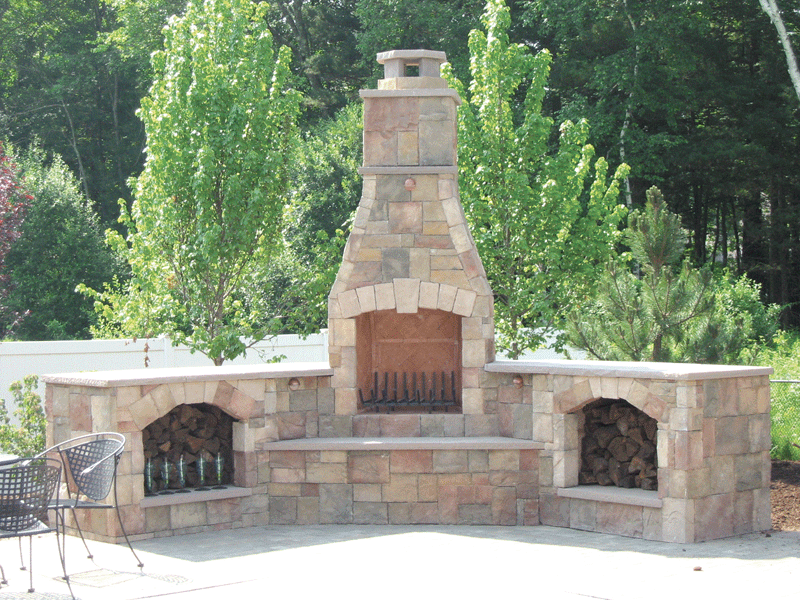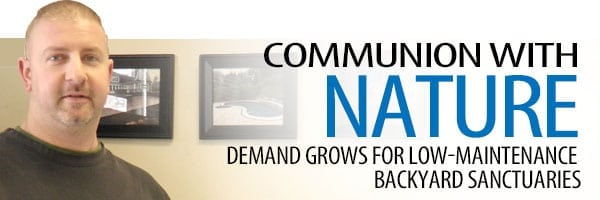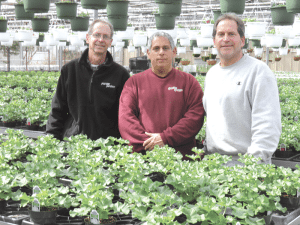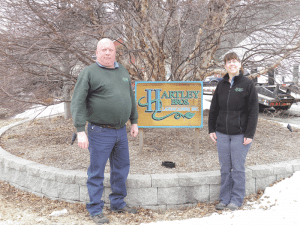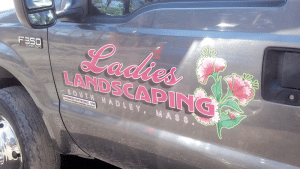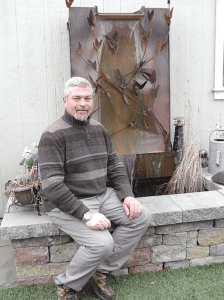Landscapers Transform Backyards, Public Spaces into Recreational Areas
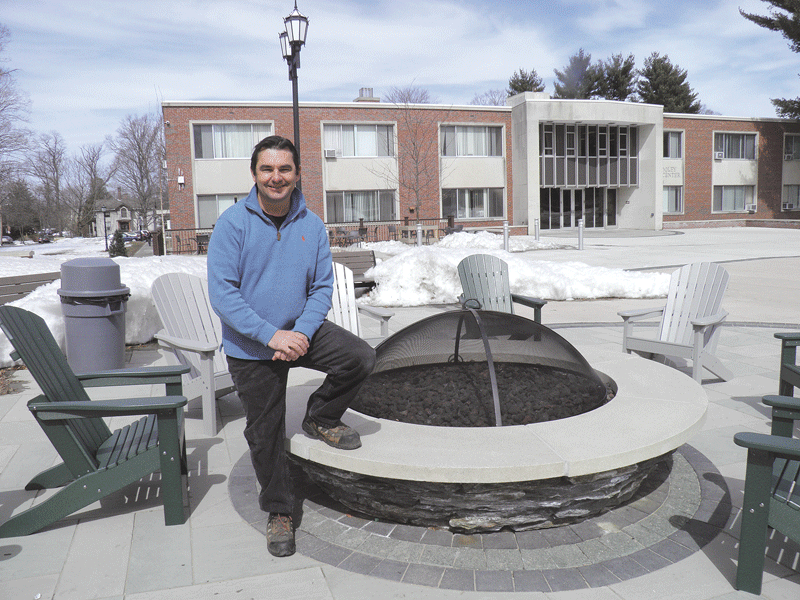
Stephen Roberts shows off a gas firepit that Elms College recently installed in a courtyard.
Last summer, a successful businessman asked Stephen Roberts to construct an edible forest on several acres of his backyard property.
“He said he wanted to go home after work and have a place where he could ‘devolve.’ He grew up on a farm and loves gardening and the outdoors,” said the owner of Stephen A. Roberts Landscape Architecture and Construction in Springfield.
The design Roberts created includes fruit trees, a trail, and a woodland area with plants that range from elderberry and pawpaw to wild ginger and wintergreen, that can be picked throughout the growing season.
Although the request was unusual and most people aren’t looking to create their own forest, local landscapers say a growing number of clients are spending money on backyard retreats that provide them with a place to entertain and enjoy the outdoors.
“Nature is very important to people’s well-being, and they travel great distances to experience mighty landscapes with mountains and oceans,” said Roberts. “But travel takes a lot of time and energy, and since people can create attractive spaces in their backyards where they can relax and spend quality time with families and friends, they are continuing to invest in outdoor rooms with amenities.”
Justin Pelis agrees.
“People are bridging the gap between their home and the outdoors,” said the co-owner of North Country Landscape and Garden Center in Westhampton. “Years ago, people simply planted shrubs and mowed their lawns. But today, they want to spend more time outdoors and are moving away from aesthetics to the experiential.”

Justin Pelis says people want the experience of growing fruits, vegetables, and herbs in their backyards with their families.
He added that an increasing number of young families want to grow vegetables and fruits with their children, watch birds and feed them, and cook outdoors in spacious kitchens boasting built-in, stainless-steel appliances.
“People are also looking to create wildlife habitats, and many want to grow wine-bearing grapes and hops,” he said. “Due to the large number of local microbreweries, people are being inspired to produce their own wine and beer, so we have been holding seminars in our garden center to teach people how to grow grapes.”
He noted that participants are taken on a tour of the nearby Blackbird Vineyard, where all of their questions are answered.
“Organic gardening and composting is also becoming popular, and we get many requests from people who want to grow their own food,” Pelis continued. “They are looking for an experience that begins with planting seeds and ends in harvesting what they have produced.”
Steve Prothers, who owns Amherst Landscape & Design Associates and has designed more than 3,000 commercial and residential landscapes, agrees that people want their backyards to be as pleasing, attractive, and fruitful as possible. Natural landscapes are in style, and he said swimming-pool areas are being updated by replacing concrete with natural stone or Travertine tiles, which come in white, tan, cream, and rust-colored varieties.
“They give the area an Old World look,” Prothers said, adding that his company specializes in hardscapes that includes patios, retaining walls, walkways, and pool surrounds. Many clients ask for a pergola, because its mini-roof gives an outdoor space the definition of a room.
“It’s a very decorative feature that frames in an area and creates an intimate space. But a pergola can also be functional because it can provide shade,” he said, noting that roof rafters can be placed close together to block the sun, or the structure can be planted with scented vines, such as wisteria or bougainvillea, that give it a tropical feel.
Pelis has built pavilions with roofs over patios that people use as sitting areas. “They put TVs in them, and the patio can extend beyond the sitting area,” he said.
In fact, patios are becoming more popular than decks because they require less maintenance. “Patios give people more flexibility to expand and can be built with pavers, which come in a wide variety of contemporary styles. Some look like wood, others look like granite, and some are very modular,” Pelis said.
Since landscaping is an ongoing process, many people have their yards done in phases and add a new area each year. However, the work often begins with creating new entryways to the house.
“Permeable pavers are being used to replace concrete,” Prothers said. “They have a softer look than concrete and allow water to be absorbed and carried away from the home.”

Nic Brown and Steve Corrigan say many towns and cities are adding spray parks for children and adults to enjoy.
Plans with a Purpose
The desire to create a backyard oasis gained momentum in 2008 when the economy tanked and so-called ‘staycations’ became a household word. But local landscapers say many people held off on projects due to uncertainty over jobs, and pent-up desires are more apt to be realized this summer than they were in the past.
“The recession impacted landscaping projects, but now that the economy is improving, I think we will get more requests,” Roberts said.
Coveted plans typically include backyard areas designated for specific activities. “It’s not unusual for a family to want a cooking area with a built-in grill, a place to sit and eat, a firepit, and another space with an outdoor couch and a coffee table,” Roberts said.
Stephen Corrigan agrees. “More and more people are spending money to create outdoor kitchens and living areas with TVs in a protected area,” said the owner of Mountain View Landscapes and Lawncare in Chicopee.
In fact, interest in outdoor cooking is heating up, and Roberts said his firm has built outdoor kitchens that include granite or faux-stone countertops and built-in appliances such as refrigerators, grills, and rotisseries. “People are taking grilling to the next level.”
Firepits have burned brightly for some time, but today, many people are turning to gas to light up the night. “People love to gather around a fire, and if they use gas, all they have to do is press a button,” Roberts said, adding that Elms College recently had his firm redesign a central courtyard that now includes a large gas firepit with Adirondack chairs. “It is turned on every afternoon and has become a popular gathering place for students and staff members.”
Another advantage of a firepit is that it can create a focal point in an outdoor living room. “People put furniture around it in the same way they would put it near a fireplace inside their house,” Prothers said.

Steve Prothers says many homeowners and businesses use pergolas to create an outdoor room, which can be aromatic if covered with flowering vines.
Water features are also in demand, but instead of swimming pools, most people are choosing simple but soothing options such as waterfalls. “They are beautiful and attract birds, but don’t require much maintenance,” Roberts said.
One client with a back problem installed a hot tub surrounded by beautiful plants with a waterfall a short distance away that could be lit up at night. “He could sit in the hot tub in the evening, enjoy the sight and sound of the waterfall, and get relief from his pain,” he noted.
Roberts added that small ponds or plunge pools are still popular. “But people don’t want to use chemicals in them. They want biological filters,” he said, explaining that the ponds he installs are typically four to five feet deep with ledges that people can sit on.
Pelis said his clients are getting away from ponds, but do want water features that look natural, and often choose a fountain or pondless waterfall that pours into a rock filtration system. “They want the sound and sight of water without having to do a lot of maintenance,” he explained, adding that another option is to have water flow from the undersides of raised patio walls into a decorative bed of stone, which filters it into a concealed basin, where it is recycled.
Plantings play an important role in landscape design, and Prothers said ground covers and plants that provide seasonal interest throughout the year are in fashion.
“But landscaping is an ongoing process, and many people do their yards in phases,” he said. “They establish an area, live with it, and then grow their plan. A good landscape design takes into consideration what things will look like five to 10 years down the road.”
Pelis added that native plants such as milkweed, which attracts Monarch butterflies, along with wildflowers and species that attract bees, have become popular as people seek to create natural environments.
Natural Alternatives
Local landscapers expect the season to begin late this year due to the volume of snow. “Spring is in the air, but people have just started to come out of hibernation,” Roberts said.
Corrigan agreed. Although his company is often working by mid-March, this year, the timeline will be pushed out until mid-April.
Most of his business is commercial, and trends are also emerging in that arena, with water conservation and stormwater runoff among the ingredients that weigh heavily in public projects today.
“Permeable pavers are an attractive, green solution that take the place of concrete and asphalt; they allow as much water as possible to be kept on the site,” said Project Manager Nic Brown.
In some cases, it is funneled into rain gardens, said Corrigan, adding that Mountain View has built parking lots with rain gardens at the perimeter where very porous soil absorbs and holds water before any overflow goes into the sewer system.
He cited the Massachusetts Green High Performance Computing Center in Holyoke and a new science building at UMass Amherst as examples of structures where water drainage has been curtailed, and said some systems are designed so rainwater and melting snow from the roof are channeled into a filtration system of tanks that feed rain gardens.
His company recently won a regional award for its work on the town square in Mansfield, Conn., in conjunction with the architect who designed it. The area is the focal point of a newly created neighborhood that contains four five-story podium buildings with 414 rental units and 101,553 square feet of commercial and retail offerings at street level adjacent to the University of Connecticut.
“We used gray and black permeable pavers in the park,” Corrigan said, showing off a photo of the attractive design. “Traditionally, pavers are installed tightly together over a gravel base with two inches of sand. These were placed three-eighths of an inch apart over a 12-inch base of crushed stone.”
Another growing trend is spray parks, and new ones will be built this year in Agawam, Springfield, Greenfield, and Northampton.
“Cities and towns are replacing swimming pools and wading pools with spray parks; they have become more and more popular in the last three to five years,” Corrigan said, adding that they provide safe, cost-effective areas where people can congregate and relax during the hot summer months.
The spray features can be programmed to go off during times set by the town, city, or organization that builds them. When someone presses the mechanism that activates the system during the specified time, the features begin to spray water in a preset sequence, and children quickly learn to run from one station to another.
“Some sprays come up from the ground, while at other stations, buckets set ten feet in the air fill with water and dump it on people beneath them,” said Corrigan. “There are hoops with water sprays that kids can run through, sprays that spurt like a geyser, and ones that look like flowers. They have come a long way in recent years.”
Growing Desire
The desire to spend time outdoors in public and private spaces continues to grow, and whether someone is planning a commercial or residential project, environmental concerns are taking an expanded role in today’s landscaping projects.
Roberts said his customers are requesting blueberry bushes, strawberries, and herbs as well as small plots where they can grow vegetables. Other landscapers report similar requests and agree that enjoying a backyard involves far more today than it did a decade ago.
“Whether people are outside watching birds, picking berries, or watching TV with their friends, they want an experience,” Pelis said. “It’s been a long, cold winter, and although we may get a later start on landscaping than we have in the past, we expect these trends to become more prevalent than ever.”








 Trees serve both practical and aesthetic functions, and people can become quite attached to them. But work to maintain, trim, and even remove trees should be left to the professionals, who say their profession is often dangerous, but in all ways rewarding.
Trees serve both practical and aesthetic functions, and people can become quite attached to them. But work to maintain, trim, and even remove trees should be left to the professionals, who say their profession is often dangerous, but in all ways rewarding.
